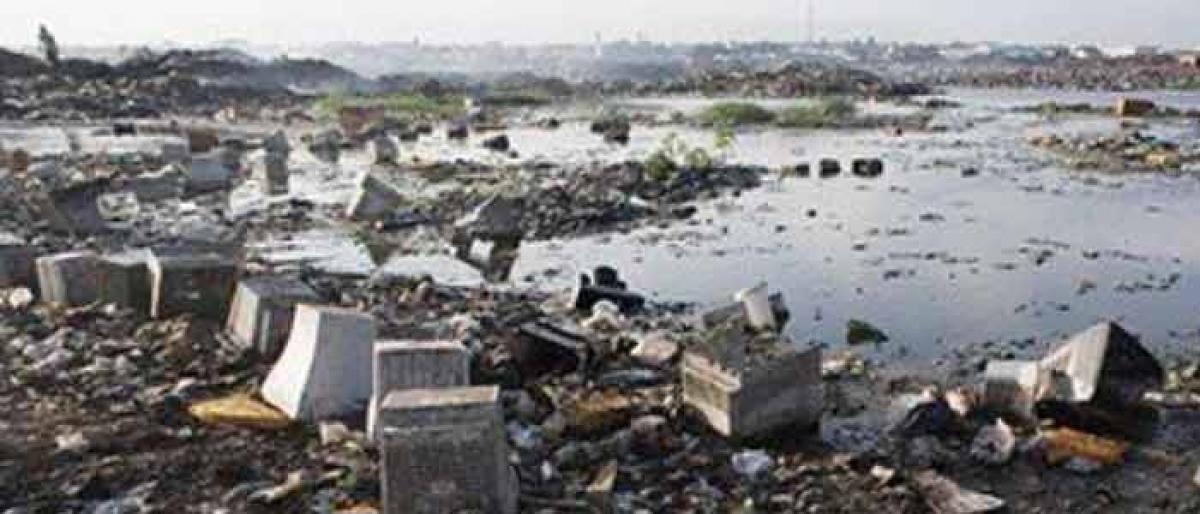Live
- DEO suspends teacher accused of sexual assault
- PM ‘cursing’ Congress out of despair: Maharashtra Cong Chief
- Applications are invited for Junior Colleges Scheme District Scheduled Castes Development Officer Ramlal
- A nomination was filed on the second day for the Nagar Kurnool parliamentary seat
- SP Gaikwad inspected the Telangana Amarnath Saleswaram Jatara yatra arrangements
- Rahul Gandhi's decision to contest from Wayanad shows 'lack of confidence': BJP President Nadda
- IPL 2024: Delhi bowlers will go after all of SRH’s top-order batters, says head coach Ricky Ponting
- At Amroha rally, PM Modi sends out ‘meaningful’ message for Muslims and Hindus
- Tripura records highest 79.83 pc voter turnout in Northeast
- The government has to clear the confusion
Just In

Srinivasan leaves his office in Bengaluru where the lights and air-conditioners are switched off when sensors planted inside notice that he is leaving. He is prompted on his e-watch as to how much time it would take for the elevator to arrive on his floor, based on movement-recognition by sensors at the entry of the corridor.
Srinivasan leaves his office in Bengaluru where the lights and air-conditioners are switched off when sensors planted inside notice that he is leaving. He is prompted on his e-watch as to how much time it would take for the elevator to arrive on his floor, based on movement-recognition by sensors at the entry of the corridor.
He utilises that time to check on his smart phone, connected to his refrigerator, the items that he needs to buy on the way. His smart phone has already received a message from the sensor in his electric vehicle (EV) that there is enough charge in the battery to reach home if he takes the club route, as other routes have heavy traffic.
Welcome to the world of Internet of Things (IoT), Cloud Networking and Machine Learning. The numbers are crazy, but as per the presentations given by Ericsson's former CEO Hans Vestburg in 2010 –and repeated by Cisco – by 2020, 50 billion devices and machines would be talking to each other. That is about six times the human population.
By 2030, as per one estimate from IBM, one trillion devices would be connected to each other in the Cloud, networking more than 100 times the human population. Scary? If yes, then the story is not even complete.
There are more than five billion mobile phone users among the world's population of 7.5 billion. That heralds 100 per cent market penetration for digital dialogue very soon. Half the world already uses Internet and digital social media. Countries are competing with each other for declaring the targets of 100 per cent EVs and banning petrol and diesel cars "earlier than thou" and growth rates of EVs in many countries are more than 60 percent.
Now take a pause and imagine something else: The horrendous amount of e-waste generated as the new models and latest versions arrive and as the existing appliances and devices retire and become "unwanted".
The sheer numbers of not only sensors but lithium batteries needed in a sharply growing market of EVs, driverless cars, mobile and smart phones, clean energy storage, along with rare-earth metals needed for sensors and PCBs for internet-based computing and CCTVs point to a nerve-racking and daunting challenge to tackle e-waste.
That waste is the dark side of the bright story of the global future. These devices, when discarded for the new versions or at the end of their life, would pose life-threatening consequences to our world.
Good news, however, is that the sound management of e-waste – starting with legislation and its enforcement –can create new areas of employment and drive entrepreneurship. The latest report of the International Telecom Union (ITU) and UN University (UNU) states that new era of emerging opportunities has arrived.
E-waste contains precious metals, including lithium, gold, silver, platinum and palladium, but it also contains valuable bulky materials such as iron, copper and aluminium along with plastics that can be reprocessed in plasma reactors and recycled. Overall, UNU estimates that the value of precious metals in e-waste is worth $60 billion.
In 2016, the Indian government, under Prime Minister Modi, issued the E-Waste (Management) Rules that place responsibility on electronic goods manufacturing companies and bulk consumers to collect and channel e-waste from consumers to authorised re-processing units. Firms are now required to set yearly collection targets linked to their production numbers. These are steps in the right direction to enhance the liability of the companies, if the enforcement is effective.
By: Rajendra Shende
(Rajendra Shende is Chairman, TERRE Policy Centre, and Director, UNEP)

© 2024 Hyderabad Media House Limited/The Hans India. All rights reserved. Powered by hocalwire.com







